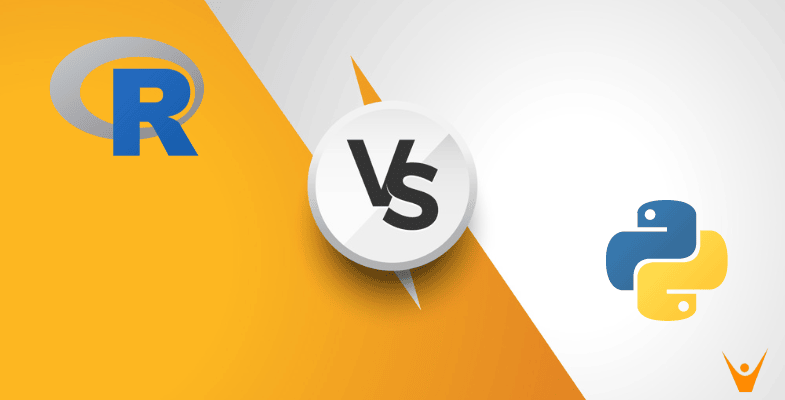As we all know, Python and R are the two most popular open-source languages for data science that may be used with Windows, macOS, and Linux. Both are often regarded as being reasonably simple languages to learn, especially for novices, and they can both handle almost any data analytic requirement.
Any data science or data analyst task can easily be accomplished with the help of Python and R. Although, the argument might occur only if an individual is new in the field and wouldn’t know that he/she might have to be well-versed in both. But, which one’s better?
This is an unsolvable argument that can lead to considering both the language’s pros and cons. So, let’s consider key points and understand which one’s closer to perfection and ease.
5 Key Differences between R and Python
R and Python are both used for numerical computation, deep learning, and data processing. Although each language has advantages and disadvantages, the user's requirements and tastes will mostly determine whether they choose Python or R. Nonetheless, let’s consider key differences between the same.
- General Syntax: When compared the syntax of R is more complicated and may take some time to understand while Python uses basic language and a clear syntax for operations.
- Manipulation Of Data: Python contains a large set of libraries to handle data like SciPy, NumPy, and Pandas which makes the tasks simpler. On the other hand, R has a smaller section of tools but its packages like tidyverse and dplyr offer more efficient methods of handling data.
- Visual Representation: Generally, both Python and R provide powerful tools for displaying data. R employs packages like ggplot2 and lattice, Python makes use of libraries like Matplotlib, Seaborn, and Plotly.
- Deep Learning: Both R and Python are used for machine learning tasks. Machine learning is frequently performed using Python's sci-kit-learn and TensorFlow libraries, while R's caret and mlr packages provide a comparable set of features.
- Community: Python is one of the highly known languages even to non-coders. Therefore, it has a larger and more diverse set of the community whereas R has the coder’s group that focuses on statistical analysis and computation.
R and Python both offer advantages and disadvantages, and your decision will mostly be influenced by your requirements and preferences. It's fair to say, nevertheless, that Python has caught up to R in terms of data analysis skills, and that it is now often employed for data science activities.
Coding in R vs Python
In R basic data manipulation can be done as follows:
# Create a vector of numbers numbers <- c(1, 2, 3, 4, 5) # Add 1 to each number using a for loop for (i in 1:length(numbers)) { numbers[i] <- numbers[i] + 1 } # Print the updated vector print(numbers) In Python, basic data manipulation can be done as follows: # Create a list of numbers numbers = [1, 2, 3, 4, 5] # Add 1 to each number using a for loop for i in range(len(numbers)): numbers[i] += 1 # Print the updated list print(numbers)
Output:
2,3,4,5,6
In the above example, a for loop is used to generate a list of numbers and add 1 to each one. As we can see, the syntax of both languages is different. In R, a vector is generated using the c() function while in Python list is created using [] brackets.
Moreover, Python uses the len() function to determine the length of the list given but in R length() function is used. Nonetheless, both codes share the same logic and functionality.
Generally, there can be considerable differences between the language and structure of R and Python programs, but the fundamental reasoning and theories utilized in data analysis are the very same.
| Python | R |
| General-purpose language | Statistical programming language |
| Syntax emphasizes code readability | Syntax optimized for statistical analysis |
| Large ecosystem of libraries and frameworks | Extensive collection of statistical packages |
| Widely used in web development, data science, and machine learning | Primarily used for statistical analysis and data manipulation |
| Object-oriented programming (OOP) support | Functional programming paradigm with OOP capabilities |
| More versatile and can be used for a wide range of applications | Focused on statistical analysis and data manipulation |
| Popular libraries: NumPy, pandas, TensorFlow, scikit-learn | Popular packages: dplyr, ggplot2, tidyr, caret |
What is used more often by data analysts?
Even though both R and Python are employed differently in the field of data analysis, the usage majorly depends on the user itself. Depending on their tastes and the particular needs of their position, data scientists may choose to analyze data using either R or Python.
R has traditionally been used by data analysts more frequently, especially in the academic and scientific fields. R offers many different tools for data analysis, visualization, and modeling and is ideal for statistical computing.
However, Python is increasingly frequently utilized for jobs like data analysis, deep learning, and other data science endeavors because of its recent surge in popularity. Many data analysis modules and frameworks, such as pandas, NumPy, and sci-kit-learn, are accessible in Python thanks to its huge and vibrant community.
What’s faster between Python and R?
Generally, R executes code more slowly than Python does. This could be due to R being an interpreted language whereas Python is a complied one.
Moreover, in interpreted languages, there are huge chances of performance slowing down and executing codes line-by-line. But, compiled languages translate the source code into machine language so that the processor can carry out tasks immediately.
Nonetheless, it is important to keep in mind that R can occasionally outperform Python in terms of speed. For instance, the speed and effectiveness of R's data manipulation tools, such as dplyr and tidyr, sometimes beat those of comparable Python libraries.
Conclusion
In this article, we discussed the key differences between R and Python. While there are some distinctions between Python and R's capabilities, it is safe to claim that Python is capable of the majority of what R is capable of.








